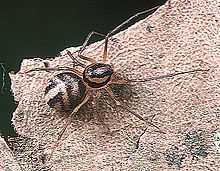Spitting spider
| Spitting spiders | |
|---|---|
.jpg) | |
| Scytodes thoracica | |
| Scientific classification | |
| Kingdom: | Animalia |
| Phylum: | Arthropoda |
| Class: | Arachnida |
| Order: | Araneae |
| Superfamily: | Scytodoidea |
| Family: | Scytodidae Blackwall, 1864 |
| Genera | |
|
see text | |
| Diversity | |
| 5 genera, 169 species | |
 | |


Spitting spiders are members of the family Scytodidae. There are several genera, of which Scytodes is the best-known. Over 150 species of scytodids have been described worldwide. This means that the Scytodes is somewhat related to the family Sicariidae commonly known as Recluse spiders being that they are part of the same superfamily.
Scytodidae catch their prey by spitting a fluid that congeals on contact into a venomous and sticky mass. Remarkably, though it is produced in venom glands in the chelicerae, the fluid contains both venom and spider silk in liquid form. The venom-impregnated silk not only immobilizes prey such as Silverfish by tying it down, but has a venomous effect as well. In high-speed moving pictures, the spiders can be observed swaying from side to side as they "spit", catching the prey in a crisscrossed "Z" pattern; it is criss-crossed because each of the chelicerae emits half of the pattern. The spider usually strikes from a distance of 10–20 mm and the whole attack sequence is over in a little under 1/700th of a second.[1] After making the capture, the spider will typically bite the prey with venomous effect, and wrap it in the normal spider fashion with silk from the spinnerets.[2]
Like the Sicariidae and Diguetidae these spiders are haplogyne (lack hardened female genitalia) and have six eyes, which are arranged as three pairs. The Scytodidae differ from the Sicariidae and Diguetidae in having a dome-shaped carapace and in their characteristic flecked pattern of spots.
When two scytodes happen to fight each other, the larger one generally is strong enough to break free from the web of the smaller, and thereby to win.[3] However, at least some species exhibit presocial behaviour, in which mature spiders live together and assist the young with food.[4]
Genera
- Dictis L. Koch, 1872 (China to Australia)
- Scyloxes Dunin, 1992 (Tajikistan)
- Scytodes Latreille, 1804 (worldwide)
- Soeuria Saaristo, 1997 (Seychelles)
- Stedocys Ono, 1995 (Malaysia, Thailand)
See also
- List of Scytodidae species
- Spider families
References
- ↑ Piper, Ross (2007), Extraordinary Animals: An Encyclopedia of Curious and Unusual Animals, Greenwood Press.
- ↑ Gilbert, C. and L. S . Rayor . 1985 . Predatory behavior of spitting spiders (Araneae, Scytodidae) and the evolution of prey wrapping. J . Arachnol., 13 :231-241
- ↑
- ↑ Miller, Jeremy. 2010. Taxon page for Scytodes socialis Miller, 2006. In: Spiders, http://araneae.lifedesks.org/pages/34605. First Created: 2010-01-29T15:58:27Z
External links
- Arachnology Home Pages: Araneae
- Info about Spitting spider Scytodes thoracica
- Platnick, N.I. 2003. World Spider Catalog
| Wikispecies has information related to: Scytodidae |
| Wikimedia Commons has media related to Scytodidae. |
| |||||||||||||||||||